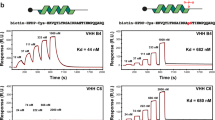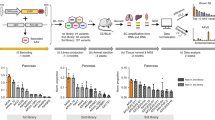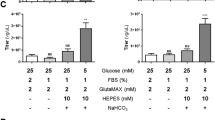Abstract
Selection of targeted vectors from virus display peptide libraries is a versatile and efficient approach to improve vector specificity and efficiency. This strategy has been used to target various cell types in vitro. Here, we report the screening of an adeno-associated virus type 2 (AAV2) display peptide library in vivo to select vectors specifically homing to heart tissue after systemic application in mice. Selected library clones indicated superior specificity of gene transfer compared with wild-type AAV2, AAV9 and a heparin binding-deficient AAV2 mutant. Such targeted vectors were able to reconstitute expression of δ-sarcoglycan in the heart of adult δ-sarcoglycan knockout mice after systemic gene transfer in vivo, attesting to the therapeutic potential of this approach.
This is a preview of subscription content, access via your institution
Access options
Subscribe to this journal
Receive 12 print issues and online access
$259.00 per year
only $21.58 per issue
Buy this article
- Purchase on Springer Link
- Instant access to full article PDF
Prices may be subject to local taxes which are calculated during checkout





Similar content being viewed by others
References
Muzyczka N, Warrington Jr KH . Custom adeno-associated virus capsids: the next generation of recombinant vectors with novel tropism. Hum Gene Ther 2005; 16: 408–416.
Glasgow JN, Everts M, Curiel DT . Transductional targeting of adenovirus vectors for gene therapy. Cancer Gene Ther 2006; 13: 830–844.
Wickham TJ . Ligand-directed targeting of genes to the site of disease. Nat Med 2003; 9: 135–139.
Sadeghi H, Hitt MM . Transcriptionally targeted adenovirus vectors. Curr Gene Ther 2005; 5: 411–427.
Le Bec C, Douar AM . Gene therapy progress and prospects—vectorology: design and production of expression cassettes in AAV vectors. Gene Ther 2006; 13: 805–813.
Brown BD, Venneri MA, Zingale A, Sergi Sergi L, Naldini L . Endogenous microRNA regulation suppresses transgene expression in hematopoietic lineages and enables stable gene transfer. Nat Med 2006; 12: 585–591.
Buning H, Ried MU, Perabo L, Gerner FM, Huttner NA, Enssle J et al. Receptor targeting of adeno-associated virus vectors. Gene Ther 2003; 10: 1142–1151.
Koerber JT, Jang JH, Schaffer DV . DNA shuffling of adeno-associated virus yields functionally diverse viral progeny. Mol Ther 2008; 16: 1703–1709.
Grimm D, Lee JS, Wang L, Desai T, Akache B, Storm TA et al. In vitro and in vivo gene therapy vector evolution via multispecies interbreeding and retargeting of adeno-associated viruses. J Virol 2008; 82: 5887–5911.
Li W, Asokan A, Wu Z, Van Dyke T, DiPrimio N, Johnson JS et al. Engineering and selection of shuffled AAV genomes: a new strategy for producing targeted biological nanoparticles. Mol Ther 2008; 16: 1252–1260.
Gao G, Vandenberghe LH, Wilson JM . New recombinant serotypes of AAV vectors. Curr Gene Ther 2005; 5: 285–297.
Bartlett JS, Kleinschmidt J, Boucher RC, Samulski RJ . Targeted adeno-associated virus vector transduction of nonpermissive cells mediated by a bispecific F(ab’gamma)2 antibody. Nat Biotechnol 1999; 17: 181–186.
Ponnazhagan S, Mahendra G, Kumar S, Thompson JA, Castillas Jr M . Conjugate-based targeting of recombinant adeno-associated virus type 2 vectors by using avidin-linked ligands. J Virol 2002; 76: 12900–12907.
Arnold GS, Sasser AK, Stachler MD, Bartlett JS . Metabolic biotinylation provides a unique platform for the purification and targeting of multiple AAV vector serotypes. Mol Ther 2006; 14: 97–106.
Ried MU, Girod A, Leike K, Buning H, Hallek M . Adeno-associated virus capsids displaying immunoglobulin-binding domains permit antibody-mediated vector retargeting to specific cell surface receptors. J Virol 2002; 76: 4559–4566.
Gigout L, Rebollo P, Clement N, Warrington Jr KH, Muzyczka N, Linden RM et al. Altering AAV tropism with mosaic viral capsids. Mol Ther 2005; 11: 856–865.
Girod A, Ried M, Wobus C, Lahm H, Leike K, Kleinschmidt J et al. Genetic capsid modifications allow efficient re-targeting of adeno-associated virus type 2. Nat Med 1999; 5: 1052–1056.
Perabo L, Endell J, King S, Lux K, Goldnau D, Hallek M et al. Combinatorial engineering of a gene therapy vector: directed evolution of adeno-associated virus. J Gene Med 2006; 8: 155–162.
Maheshri N, Koerber JT, Kaspar BK, Schaffer DV . Directed evolution of adeno-associated virus yields enhanced gene delivery vectors. Nat Biotechnol 2006; 24: 198–204.
Warrington Jr KH, Gorbatyuk OS, Harrison JK, Opie SR, Zolotukhin S, Muzyczka N . Adeno-associated virus type 2 VP2 capsid protein is nonessential and can tolerate large peptide insertions at its N terminus. J Virol 2004; 78: 6595–6609.
Lux K, Goerlitz N, Schlemminger S, Perabo L, Goldnau D, Endell J et al. Green fluorescent protein-tagged adeno-associated virus particles allow the study of cytosolic and nuclear trafficking. J Virol 2005; 79: 11776–11787.
Loiler SA, Conlon TJ, Song S, Tang Q, Warrington KH, Agarwal A et al. Targeting recombinant adeno-associated virus vectors to enhance gene transfer to pancreatic islets and liver. Gene Ther 2003; 10: 1551–1558.
Shi W, Arnold GS, Bartlett JS . Insertional mutagenesis of the adeno-associated virus type 2 (AAV2) capsid gene and generation of AAV2 vectors targeted to alternative cell- surface receptors. Hum Gene Ther 2001; 12: 1697–1711.
Wu P, Xiao W, Conlon T, Hughes J, Agbandje-McKenna M, Ferkol T et al. Mutational analysis of the adeno-associated virus type 2 (AAV2) capsid gene and construction of AAV2 vectors with altered tropism. J Virol 2000; 74: 8635–8647.
Yang Q, Mamounas M, Yu G, Kennedy S, Leaker B, Merson J et al. Development of novel cell surface CD34-targeted recombinant adenoassociated virus vectors for gene therapy. Hum Gene Ther 1998; 9: 1929–1937.
Kern A, Schmidt K, Leder C, Muller OJ, Wobus CE, Bettinger K et al. Identification of a heparin-binding motif on adeno-associated virus type 2 capsids. J Virol 2003; 77: 11072–11081.
Opie SR, Warrington Jr KH, Agbandje-McKenna M, Zolotukhin S, Muzyczka N . Identification of amino acid residues in the capsid proteins of adeno-associated virus type 2 that contribute to heparan sulfate proteoglycan binding. J Virol 2003; 77: 6995–7006.
Grifman M, Trepel M, Speece P, Gilbert LB, Arap W, Pasqualini R et al. Incorporation of tumor-targeting peptides into recombinant adeno- associated virus capsids. Mol Ther 2001; 3: 964–975.
Shi W, Bartlett JS . RGD inclusion in VP3 provides adeno-associated virus type 2 (AAV2)-based vectors with a heparan sulfate-independent cell entry mechanism. Mol Ther 2003; 7: 515–525.
White SJ, Nicklin SA, Buning H, Brosnan MJ, Leike K, Papadakis ED et al. Targeted gene delivery to vascular tissue in vivo by tropism-modified adeno-associated virus vectors. Circulation 2004; 109: 513–519.
Work LM, Nicklin SA, Brain NJ, Dishart KL, Von Seggern DJ, Hallek M et al. Development of efficient viral vectors selective for vascular smooth muscle cells. Mol Ther 2004; 9: 198–208.
Nicklin SA, Buening H, Dishart KL, de Alwis M, Girod A, Hacker U et al. Efficient and selective aav2-mediated gene transfer directed to human vascular endothelial cells. Mol Ther 2001; 4: 174–181.
Perabo L, Buning H, Kofler DM, Ried MU, Girod A, Wendtner CM et al. In vitro selection of viral vectors with modified tropism: the adeno-associated virus display. Mol Ther 2003; 8: 151–157.
Muller OJ, Kaul F, Weitzman MD, Pasqualini R, Arap W, Kleinschmidt JA et al. Random peptide libraries displayed on adeno-associated virus to select for targeted gene therapy vectors. Nat Biotechnol 2003; 21: 1040–1046.
Waterkamp DA, Muller OJ, Ying Y, Trepel M, Kleinschmidt JA . Isolation of targeted AAV2 vectors from novel virus display libraries. J Gene Med 2006; 8: 1307–1319.
Bupp K, Roth MJ . Altering retroviral tropism using a random-display envelope library. Mol Ther 2002; 5: 329–335.
Bupp K, Sarangi A, Roth MJ . Probing sequence variation in the receptor-targeting domain of feline leukemia virus envelope proteins with peptide display libraries. J Virol 2005; 79: 1463–1469.
Muller OJ, Leuchs B, Pleger ST, Grimm D, Franz WM, Katus HA et al. Improved cardiac gene transfer by transcriptional and transductional targeting of adeno-associated viral vectors. Cardiovasc Res 2006; 70: 70–78.
Inagaki K, Fuess S, Storm TA, Gibson GA, McTiernan CF, Kay MA et al. Robust systemic transduction with AAV9 vectors in mice: efficient global cardiac gene transfer superior to that of AAV8. Mol Ther 2006; 14: 45–53.
Michelfelder S, Kohlschutter J, Skorupa A, Pfennings S, Muller O, Kleinschmidt JA et al. Successful expansion but not complete restriction of tropism of adeno-associated virus by in vivo biopanning of random virus display peptide libraries. PLoS ONE 2009; 4: e5122.
Hack AA, Lam MY, Cordier L, Shoturma DI, Ly CT, Hadhazy MA et al. Differential requirement for individual sarcoglycans and dystrophin in the assembly and function of the dystrophin-glycoprotein complex. J Cell Sci 2000; 113 (Part 14): 2535–2544.
Gregorevic P, Blankinship MJ, Allen JM, Crawford RW, Meuse L, Miller DG et al. Systemic delivery of genes to striated muscles using adeno-associated viral vectors. Nat Med 2004; 10: 828–834.
Nakai H, Fuess S, Storm TA, Muramatsu S, Nara Y, Kay MA . Unrestricted hepatocyte transduction with adeno-associated virus serotype 8 vectors in mice. J Virol 2005; 79: 214–224.
Sun B, Zhang H, Franco LM, Young SP, Schneider A, Bird A et al. Efficacy of an adeno-associated virus 8-pseudotyped vector in glycogen storage disease type II. Mol Ther 2005; 11: 57–65.
Pacak CA, Mah CS, Thattaliyath BD, Conlon TJ, Lewis MA, Cloutier DE et al. Recombinant adeno-associated virus serotype 9 leads to preferential cardiac transduction in vivo. Circ Res 2006; 99: e3–e9.
Hajitou A, Trepel M, Lilley CE, Soghomonyan S, Alauddin MM, Marini 3rd FC et al. A hybrid vector for ligand-directed tumor targeting and molecular imaging. Cell 2006; 125: 385–398.
Zincarelli C, Soltys S, Rengo G, Rabinowitz JE . Analysis of AAV serotypes 1-9 mediated gene expression and tropism in mice after systemic injection. Mol Ther 2008; 16: 1073–1080.
Yang L, Jiang J, Drouin LM, Agbandje-McKenna M, Chen C, Qiao C et al. A myocardium tropic adeno-associated virus (AAV) evolved by DNA shuffling and in vivo selection. Proc Natl Acad Sci USA 2009; 106: 3946–3951.
Huttner NA, Girod A, Perabo L, Edbauer D, Kleinschmidt JA, Buning H et al. Genetic modifications of the adeno-associated virus type 2 capsid reduce the affinity and the neutralizing effects of human serum antibodies. Gene Ther 2003; 10: 2139–2147.
Zhu T, Zhou L, Mori S, Wang Z, McTiernan CF, Qiao C et al. Sustained whole-body functional rescue in congestive heart failure and muscular dystrophy hamsters by systemic gene transfer. Circulation 2005; 112: 2650–2659.
Dubielzig R, King JA, Weger S, Kern A, Kleinschmidt JA . Adeno-associated virus type 2 protein interactions: formation of pre-encapsidation complexes. J Virol 1999; 73: 8989–8998.
Zolotukhin S, Potter M, Hauswirth WW, Guy J, Muzyczka N . A ‘humanized’ green fluorescent protein cDNA adapted for high-level expression in mammalian cells. J Virol 1996; 70: 4646–4654.
Grimm D, Kay MA, Kleinschmidt JA . Helper virus-free, optically controllable, and two-plasmid-based production of adeno-associated virus vectors of serotypes 1 to 6. Mol Ther 2003; 7: 839–850.
Wang Z, Ma HI, Li J, Sun L, Zhang J, Xiao X . Rapid and highly efficient transduction by double-stranded adeno-associated virus vectors in vitro and in vivo. Gene Ther 2003; 10: 2105–2111.
Gao G, Vandenberghe LH, Alvira MR, Lu Y, Calcedo R, Zhou X et al. Clades of adeno-associated viruses are widely disseminated in human tissues. J Virol 2004; 78: 6381–6388.
Hauswirth WW, Lewin AS, Zolotukhin S, Muzyczka N . Production and purification of recombinant adeno-associated virus. Methods Enzymol 2000; 316: 743–761.
Veldwijk MR, Topaly J, Laufs S, Hengge UR, Wenz F, Zeller WJ et al. Development and optimization of a real-time quantitative PCR-based method for the titration of AAV-2 vector stocks. Mol Ther 2002; 6: 272–278.
Acknowledgements
We thank the vector production unit at the German Cancer Research Center for vector preparations. We thank Dr X Xiao (University of Pittsburgh) for providing the pdsAAV-CMV-GFP construct and Dr D Weichenhan and S Schinkel (University of Heidelberg) for providing the murine δ-sarcoglycan cDNA and C Raupp for valuable help. JAK, MT and OM are supported by grants of the Deutsche Forschungsgemeinschaft (KL 516/8-2; TR-448/5-3; Mu 1654/3-2).
Author information
Authors and Affiliations
Corresponding author
Ethics declarations
Competing interests
The authors declare no conflict of interest.
Additional information
Supplementary Information accompanies the paper on Gene Therapy website
Rights and permissions
About this article
Cite this article
Ying, Y., Müller, O., Goehringer, C. et al. Heart-targeted adeno-associated viral vectors selected by in vivo biopanning of a random viral display peptide library. Gene Ther 17, 980–990 (2010). https://doi.org/10.1038/gt.2010.44
Received:
Revised:
Accepted:
Published:
Issue Date:
DOI: https://doi.org/10.1038/gt.2010.44
Keywords
This article is cited by
-
Optogenetics in cardiology: methodology and future applications
International Journal of Arrhythmia (2022)
-
Optimization of AAV vectors to target persistent viral reservoirs
Virology Journal (2021)
-
Multiplexed Cre-dependent selection yields systemic AAVs for targeting distinct brain cell types
Nature Methods (2020)
-
Optimization of design and production strategies for novel adeno-associated viral display peptide libraries
Gene Therapy (2017)
-
Pulmonary Targeting of Adeno-associated Viral Vectors by Next-generation Sequencing-guided Screening of Random Capsid Displayed Peptide Libraries
Molecular Therapy (2016)



